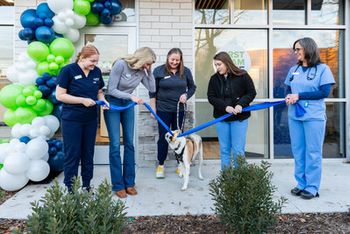
Rolling strikes every time
The premise of the TV show "Ed" isn't original: lawyer Ed opens a professional practice in a bowling alley. Dr. Kovacic beat NBC to the punch in 1988 when he moved Animal Emergency Center in Milwaukee into a leased space in a bowling alley. Dr. Rebecca Kirby, Dipl. ACVIM, Dipl. ACVECC, once a partner and now sole shareholder, remembers the location fondly: "We couldn't tell if it was thundering or someone made a strike," she says.
By Carolyn Chapman, special assignments editor
The premise of the TV show "Ed" isn't original: lawyer Ed opens a professional practice in a bowling alley. Dr. Kovacic beat NBC to the punch in 1988 when he moved Animal Emergency Center in Milwaukee into a leased space in a bowling alley. Dr. Rebecca Kirby, Dipl. ACVIM, Dipl. ACVECC, once a partner and now sole shareholder, remembers the location fondly: "We couldn't tell if it was thundering or someone made a strike," she says.
Despite her nostalgia, in 1999 Dr. Kirby abandoned the bowling alley in favor of a new 11,600-square-foot freestanding hospital. The judges of Veterinary Economics' 2000 Hospital Design Competition enjoyed the look of the new hospital. "This practice features an attractive exterior with a dramatic entry," one judge remarked.
The city lends a hand
A space crunch coupled with a declining neighborhood encouraged Dr. Kirby to move. "We really needed larger workspaces and more room for equipment," she explains. But above all, Dr. Kirby wanted a more visible location to help clients find the hospital, especially at night.
With her lease about to expire, Dr. Kirby uncovered a city program to redevelop a blighted area. "The city received a $30 million federal grant to renovate a two-mile strip and offered land at a reasonable price," she says. The city even paid all environmental clean-up costs. And the fact that the site was eight miles from her hospital didn't concern Dr. Kirby because she only sees referral cases.
To secure a 1.6-acre plot, Dr. Kirby developed a comprehensive presentation, including tapes of television news reports about the practice. "We even included letters from the police department because we treat Milwaukee police dogs," she says. When city representatives expressed concern about noise, Dr. Kirby shared her philosophy: "If dogs are healthy enough to bark, they're healthy enough to go home." The city agreed when she explained that the hospital doesn't board pets.
Dr. Kirby completed paperwork to secure a Small Business Administration loan, but the interest rates exceeded her bank's by the time the hospital was occupied. She paid an additional 5 percent to secure conventional bank financing, which saved her $2,000 a month for 15 years.
As part of the redevelopment program, the city restricted the hospital's exterior to "a contemporary interpretation of historical architecture" and closely inspected landscaping plans. The city's redevelopment dream came true: The practice is flanked by a physician's complex and a senior citizen's minimum care facility.
Design features mobility
Dr. Kirby wanted a local architect to handle the project. During his interview, Richard Suminski of Balesrieri-Kehoe in Elkhorn, Wis., impressed her by listening to her goals and asking questions. "Most of the architects I interviewed said this project would be a breeze, yet they had no concept of designing a veterinary hospital," says Dr. Kirby. "Richard was a novice with veterinary hospitals, too, but he took the initiative to explore zoning and obtain permits before I hired him."
The city mandated the all-brick exterior and old-fashioned light posts. A standing seam roof floating above a band of clerestory windows caps the vaulted entry and attracts attention to the 24-hour facility, which draws patients from a 50-mile radius.
Inside, a large, homey reception area puts anxious clients at ease. While many emergency clinics skip the pampering, Dr. Kirby included abundant windows, an oak desk, and comfortable furniture. She also built a family room near the reception area to give clients a private place to spend time with their pets. "Our clients feel the same stress a parent feels with a sick child," she says. "These features make their visit as pleasant as possible."
Dr. Kirby and her staff members use the exam rooms primarily for consultations. "They're nice, but we don't spend much time there," she says. Neither do clients, who often follow their pets to the treatment area. "We enjoy showing off the facility, and seeing our high-tech equipment assures clients that their pets are receiving the best care available," she says.
For the working areas, Dr. Kirby expanded on the treatment area and ICU layout of her former hospital. Crash carts sit between two resuscitation tables, and each room features mobile catheter and bandage carts. In addition, laparoscopy, endoscopy, and ultrasonography equipment sits on carts to maximize space and flexibility in the treatment area.
Because the hospital is staffed around the clock, Dr. Kirby included exercise equipment in the break room. And the senior doctors, including three who are board-certified in emergency and critical care and one in surgery, each have a private office in the administration corridor. A separate nurses' office gives team members space to make calls or update records.
A commitment to teaching
Dr. Kirby came to Animal Emergency Center from the University of Pennsylvania, where she was an associate professor of emergency and critical care and director of emergency services. "This was one of the first privately owned overnight emergency facilities in the country," she says. In 1991, it became one of the first private teaching hospitals, offering both internship and residency programs.
Dr. Kirby now employs three interns and nine residents who are preparing for their board exams. She says the students keep her--and the hospital--on the cutting edge. "The students constantly comment on recent journal articles they've read," says Dr. Kirby. "They're so enthusiastic about veterinary medicine."
That enthusiasm lightens the mood, Dr. Kirby says. "We do everything we can to focus on the positive. Someone cries here every day. But for every sad case, there are many happy endings to keep us going," she says.
January 2001 Veterinary Economics
Newsletter
From exam room tips to practice management insights, get trusted veterinary news delivered straight to your inbox—subscribe to dvm360.




